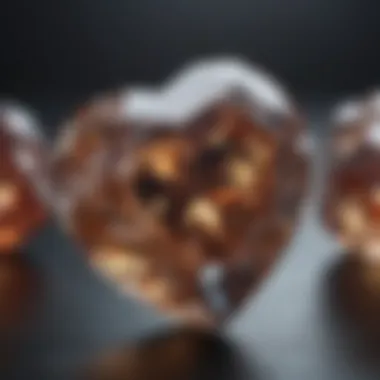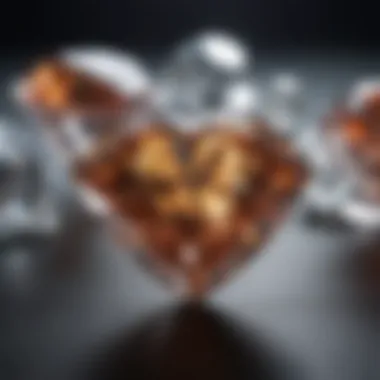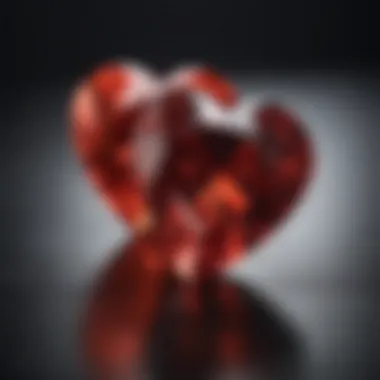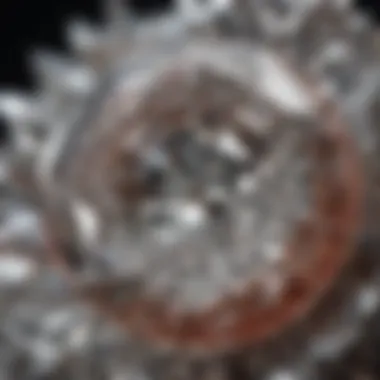True Hearts vs. Ideal Cut: A Comprehensive Guide


Intro
Diamonds have fascinated humanity for centuries, not only for their beauty but also for the engineering skill required to cut them. Among the myriad of diamond cuts available today, True Hearts and Ideal Cut stand out as two prominent classifications. Understanding these cuts is crucial for anyone who is considering purchasing a diamond. This article will explore each cut's characteristics, grading criteria, and their implications in the jewelry market.
Gemstone Overview
Definition and Origins
True Hearts diamonds are a specific type of round brilliant cut known for their exceptional symmetry and light performance. The term "True Hearts" signifies a perfect alignment of facets, resulting in a distinct heart shape pattern when viewed from the bottom. This cut was popularized by several high-end diamond retailers as a way to stand out, claiming superior quality in terms of light dispersion and fire.
On the other hand, Ideal Cut diamonds represent a more general classification. An Ideal Cut diamond is one that exhibits the optimal proportions and angles for maximum brilliance and sparkle. The Ideal Cut has its origins in the work of Marcel Tolkowsky, who in the early 20th century developed a mathematical model for the perfect diamond cut. Both cuts share a commitment to beauty, yet their manufacturing processes and resulting attributes differentiate them.
Historical Significance
Historically, diamond cutting evolved from a necessity for industrial use to an art form embraced by jewelers. The Ideal Cut gained prominence as a benchmark for diamond quality, ensuring that the stone achieved the best visual performance. True Hearts emerged later, riding on the coattails of the Ideal Cut's success but catering to consumers seeking specific aesthetic traits. This indicates the market's continuous evolution towards consumer preference and industry standards.
Gemstone Properties
Hardness and Durability
Diamonds, by nature, are the hardest known natural material. They score a 10 on the Mohs scale of mineral hardness, which means they resist scratching from all other substances. Both True Hearts and Ideal Cut diamonds maintain this unparalleled durability, making them excellent choices for daily wear in engagement rings and other jewelry pieces.
Color and Clarity
Diamonds are also graded based on color and clarity. The most valued diamonds are colorless or near-colorless. True Hearts and Ideal Cut diamonds are often available in a range of colors. Clarity refers to the presence of inclusions, or blemishes, within the stone. Both cuts can showcase clarity grades ranging from flawless to included, with the highest grades ensuring visibility enhancement and overall appearance.
The choice between a True Hearts and an Ideal Cut may also affect one's perceived color and clarity due to the way each cut optimizes light.
"Understanding these nuances can lead to a more informed decision, one grounded in both aesthetics and value considerations."
The next sections will delve deeper into the specific grading criteria, cutting processes, and the implications of these distinctions for buyers. Understanding these factors will provide a clearer picture and assist in making an informed decision when purchasing a diamond.
Preface to Diamond Cuts
The world of diamonds is intricate and layered, with the cut being one of the most significant factors that determines a diamond's overall beauty and value. Understanding diamond cuts provides insight into how light interacts with the stone and affects its appearance. Many consumers, particularly those not well-versed in gemstones, may overlook the importance of cut, focusing instead on carat weight or color. However, the cut is where the true artistry and craftsmanship of the diamond emerge.
Diamonds are cut in several shapes and styles, from classic round to fancy shapes like pear or cushion. Each style impacts how light is reflected and refracted, thus contributing to the sparkle and fire for which diamonds are renowned. The introduction to diamond cuts in this article serves as a fundamental building block for further exploration into specific cuts, including True Hearts and Ideal Cut. This context is critical for gemstone enthusiasts aiming to deepen their comprehension of not only diamond beauty but also the nuances that differentiate one cut from another.
Understanding diamond cuts enables buyers to make more informed decisions. It serves as a guide for evaluating what features are most important to them, whether it is brilliance, scintillation, or overall aesthetic appeal. When selecting a diamond, recognizing how much cut influences these aspects can lead to a more satisfying purchase experience.
Understanding Diamond Cuts
Diamond cut refers to how a diamond has been shaped and faceted, and it significantly affects the stone's ability to reflect light. The cut grades range from poor to excellent, with a specific focus on parameters like proportions, symmetry, and polish. Proper proportions of each facet determine how well a diamond can capture and return light. For instance, a well-cut diamond will reflect light internally and then back out through the table, creating optimal brilliance and sparkle.
Some common diamond cut shapes include:
- Round
- Princess
- Emerald
- Oval
- Pear
Each shape presents unique characteristics. For example, round diamonds typically maximize brilliance due to their symmetrical shape, while fancy shapes may offer a more distinctive appearance.


Additionally, the cut also includes considerations regarding the overall craftsmanship, impacting everything from the sharpness of the facets to the uniformity of the stone’s outline. Understanding these factors is essential not just for shoppers but also for collectors and jewelry designers who seek to appreciate the artistic qualities of different diamond cuts.
Significance of Cut in Diamonds
The significance of cut goes beyond aesthetics; it directly affects the diamond's performance in terms of light return and visual appeal. A beautiful diamond can lack impact if poorly cut, leading to a dull appearance. Thus, the cut is often regarded as the most crucial element in the overall assessment of a diamond.
- Light Performance: The way light travels through a diamond and how it is reflected or refracted plays a major role in its desirability. A well-cut diamond will show brilliance, scintillation, and fire, which are all terms anchoring the sparkle and visual behavior under various light conditions.
- Value Assessment: The quality of the cut usually bears a significant influence on the diamond’s market value. Diamonds rated with higher cut grades often fetch a premium price due to the compelling visual experience they provide.
- Consumer Attraction: For consumers, understanding the significance of cut can lead them to appreciate their choice beyond mere aesthetics, recognizing the engineering and craftsmanship involved.
In summary, cut is not simply about a diamond’s layout; it is a critical aspect that determines whether a diamond will captivate its audience and command a premium in the marketplace.
What is True Hearts?
Understanding the concept of True Hearts is fundamental for discerning buyers in the diamond market. This cut, though less ubiquitous than the Ideal Cut, possesses remarkable attributes that appeal to specific tastes. It offers a unique combination of brilliance and fire, which intrigues both gemstone enthusiasts and collectors alike. A comprehensive grasp of True Hearts allows buyers to appreciate the subtleties that set this diamond apart in terms of visual appeal and craftsmanship.
Definition of True Hearts
True Hearts is a particular style of diamond cut that emphasizes the heart-shaped facets beneath the crown of the stone. This cut correlates closely with the round brilliant cut but introduces a distinct pattern of hearts and arrows, which becomes visible when the diamond is viewed under magnification. This design not only amplifies the stone's brilliance but also enhances its ability to reflect light. For many, the True Hearts designation assures a certain level of quality and aesthetic refinement, serving as a hallmark for discerning consumers.
Characteristics of True Hearts Cut
The True Hearts cut is defined by its unique facet arrangement. Key characteristics include:
- Symmetrical Design: The hearts-and-arrows pattern provides a rigid symmetry, which can significantly affect the visual impact of the diamond.
- Brilliance and Fire: True Hearts engages light dynamically, yielding sparkles without sacrificing depth or clarity.
- Ideal Proportions: The proportions are meticulously calculated, addressing optimal angles that facilitate light return, enhancing beauty.
- Finish Quality: High-quality finishes in True Hearts diamonds can enhance overall appearance and performance.
The balance between these elements results in a stunning visual quality that often captivates buyers.
Cutting Precision and Techniques
The craftsmanship behind True Hearts diamonds is central to their allure. Precision cutting techniques involve:
- Advanced Technology: Modern cutting tools and technology ensure the facets are cut with exacting accuracy, leading to the distinct hearts-and-arrows shape.
- Expert Knowledge: Experienced gem cutters utilize skills honed over many years, balancing aesthetics with functionality to maximize brilliance.
- Detail Orientation: Every aspect of the cutting process from rough stone selection to final polishing requires meticulous attention to detail.
This dedication to precision not only enhances the diamond's visual qualities but yields stones that achieve superior light performance.
Visual Appeal of True Hearts Diamonds
The appeal of True Hearts diamonds lies in their visual characteristics. The heart and arrow pattern creates stunning optical effects which charm viewers. Elements like light dispersion and reflection are noticeable at various angles, delivering a dance of light that draws the eye.
In addition to brilliance, the unique cut provides:
- Aesthetic Distinction: The hearts and arrows pattern is highly sought after by those looking for both beauty and subtle emotion.
- Versatility: The True Hearts cut works well in various settings, from earrings to engagement rings, making it a practical choice for many occasions.
- Symbolism: The heart shape not only conveys love but adds a personal touch, making it a popular choice for sentimental gifts.
What is Ideal Cut?
The Ideal Cut diamond holds a significant place in the landscape of diamond grading and selection. Defined by its proportions and symmetry, the Ideal Cut is often described as the benchmark for diamond brilliance and sparkle. Understanding the concept of Ideal Cut is crucial for consumers aiming to make informed purchasing decisions.
Definition of Ideal Cut
The Ideal Cut refers to a diamond that has been crafted to achieve maximum brilliance and fire through optimal proportions. This cut is specifically designed to enhance light performance, allowing maximum light to enter the stone and reflect back to the observer. Generally, an Ideal Cut diamond will exhibit a specific range of proportions that optimize its ability to reflect light, creating an appealing visual effect.


Characteristics of Ideal Cut Diamonds
Ideal Cut diamonds share several common characteristics that distinguish them from other cuts. These include:
- Proportions: An Ideal Cut diamond typically features specific ratios between its height and diameter. For round diamonds, this often means a total depth percentage of around 60-62% and a table percentage of about 53-57%.
- Symmetry: An essential characteristic of the Ideal Cut is its symmetry. The facets must align perfectly, ensuring light travels through the diamond in a balanced manner.
- Faceting: Practices such as the number and arrangement of facets contribute to the Ideal Cut's excellence. Round diamonds generally have 58 facets.
Cutting Techniques and Standards
The cutting techniques employed in creating Ideal Cut diamonds are rigorous and precise. Gemologists refer to specific grading standards set forth by organizations such as the Gemological Institute of America (GIA). The cutting process involves:
- Planning the Rough Stone: A skilled cutter analyzes the rough diamond to determine the best way to maximize its potential. They must consider inclusions, weight retention, and overall aesthetics.
- Precision Cutting: Using advanced tools and machinery, cutters create the diamond's facets with exact angles to enhance its reflective qualities.
Aesthetic Qualities of Ideal Cut Diamonds
The beauty of Ideal Cut diamonds comes from their remarkable optical properties. The symmetrical arrangement of facets encourages light to refract in such a way that sparks a dazzling display of fire and brilliance. Consumers often appreciate several aesthetic qualities including:
- Brilliance: The Ideal Cut maximizes white light reflection, giving the diamond a bright appearance.
- Fire: Due to its precise cutting, these diamonds diffuse light into rainbow colors.
- Scintillation: The way light dances across the surface when the diamond is moved contributes to its overall allure.
"An Ideal Cut diamond is often likened to a finely tuned instrument; each facet plays a crucial role in its ability to reflect light and captivate the beholder."
When well-executed, the characteristics outlined make the Ideal Cut a sought-after choice for diamond buyers, emphasizing both visual appeal and expert craftsmanship.
Comparative Analysis of True Hearts and Ideal Cut
The comparative analysis of True Hearts and Ideal Cut diamonds holds significant relevance in understanding the nuances of their features and merits. Both cuts represent popular choices among jewelry buyers, but they differ in various aspects that influence their visual appeal and value. This analysis helps potential buyers make informed decisions based on performance metrics, grading criteria, and economic factors.
Grading Criteria for Both Cuts
Grading criteria are vital when comparing diamond cuts. For True Hearts, the grading focuses heavily on precise symmetry and laser-cutting techniques. Each facet's alignment is critical, as this cut is designed to enhance light performance, resulting in maximum brilliance. True Hearts diamonds generally earn accolades for their hearts and arrows effect, an optical phenomenon that demonstrates superior craftsmanship.
On the other hand, Ideal Cut diamonds emphasize proportion and light reflection. Specific angles and proportions are meticulously calculated to achieve optimal brilliance. Institutions like the Gemological Institute of America (GIA) apply rigorous standards, including table percentage and depth percentage, when grading these diamonds. Both cuts offer high-quality standards, yet their grading criteria reflect their unique design intentions.
Performance Metrics and Light Return
The performance metrics are essential in assessing the quality of these diamond cuts. True Hearts diamonds tend to exhibit superior light return due to their ideal symmetry and facet angles. They reflect light in a striking way, creating vivid sparkles that capture attention. This aspect is significantly appealing for consumers who prioritize the visual allure of a diamond.
In contrast, Ideal Cut diamonds present excellent light performance as well; however, they may lack the distinct optical characteristics often seen in True Hearts. While both cuts exhibit exceptional brightness, True Hearts provide a more personalized experience for buyers who seek unique visual effects.
"A well-cut diamond distinguishes itself through its brilliance and fire, captivating the beholder's eye at first glance."
Price Comparison and Economic Factors
Pricing differences between True Hearts and Ideal Cut diamonds vary, often depending on their availability and demand in the market. True Hearts diamonds are frequently priced higher due to their meticulous crafting process. The demand for this cut often leads to a premium price tag that reflects its unique visual properties.
Ideal Cut diamonds, while also commanding a decent price, tend to be more accessible in the market. Their generally widespread availability offers buyers more options in terms of budget. Both cuts exhibit a range of prices, suggesting that economic factors, along with personal taste, play a crucial role in determining the final purchasing decision.
Consumer Preferences and Trends
Consumer preferences have evolved, significantly influencing trends surrounding True Hearts and Ideal Cut diamonds. A segment of buyers still values the traditional appeal of Ideal Cut diamonds, while others are leaning towards the distinctive characteristics of True Hearts that provide a modern twist on diamond aesthetics. The demand fluctuates based not only on personal styles but also on the ongoing dialogue in gemstone enthusiast communities and jewelry design trends.


As awareness grows regarding the intricacies of diamond cuts, a more informed consumer base emerges, focused on the cut’s implications on aesthetics and value.
Implications for Buyers
When purchasing a diamond, understanding the implications of choosing between True Hearts and Ideal Cut is pivotal. Each cut offers distinct advantages that cater to different preferences and budgets. The decision goes beyond mere aesthetics; it involves evaluating several factors such as craftsmanship, light performance, and long-term value.
This article delves deep into the advantages of each cut and provides buyers with insights that can influence their purchasing decisions. Knowing the features of True Hearts and Ideal Cut diamonds helps buyers navigate the often-complex world of jewelry.
Choosing Between True Hearts and Ideal Cut
Selecting between True Hearts and Ideal Cut diamonds is not merely a matter of visual appeal. True Hearts diamonds emphasize the heart and arrow pattern, providing a specific type of beauty preferred by many collectors. These diamonds often exhibit exceptional light performance due to their specific faceting.
On the other hand, Ideal Cut diamonds are defined by their proportions and symmetry. A buyer may lean towards Ideal Cut for its promise of the best brilliance and fire. It is essential to consider what aspects of a diamond matter most: Are you drawn to the crafting precision of a True Hearts diamond, or do you prioritize the standardized excellence of an Ideal Cut?
Evaluating Personal Taste and Style
Personal taste plays a significant role in deciding the right diamond cut. True Hearts diamonds may appeal to individuals who favor unique craftsmanship and optical performance. Collectors and enthusiasts might be attracted to the technical detail behind the cut, appreciating the effort behind its creation.
Conversely, Ideal Cut diamonds might suit those who value tradition and seek a universally recognized standard. This cut is often preferred in engagements due to its classic elegance. Factors to consider include:
- Style Preference: Do you lean towards modern or classic designs?
- Color and Clarity Considerations: How do these impact your choice?
Identifying personal style helps in making a purchase that is satisfying in the long run.
Understanding Value Retention
Value retention in diamonds is crucial for buyers, especially those looking at them as an investment. Both True Hearts and Ideal Cut could maintain their value, but due to their unique features, their market appeal may fluctuate. True Hearts diamonds might garner attention from niche collectors, which can impact their resale potential.
In contrast, Ideal Cut diamonds tend to have broader market acceptance, often ensuring more stable value over time.
- Market Demand: Keep an eye on trends in the diamond market.
- Rarity: Unique cuts like True Hearts may be less common, which can influence value.
Ultimately, being informed about the resale potential of the diamond you are choosing can safeguard your investment and help in making a well-rounded decision.
End
In this article, we have examined the important distinctions between True Hearts and Ideal Cut diamonds. Understanding the specifics of these cuts can significantly impact the choices made by buyers and gemstone enthusiasts alike. The nuances in design, cutting precision, and light performance emphasize the need to be well-informed when selecting a diamond.
By evaluating the characteristics of both cuts, we delve into various factors such as grading criteria, aesthetic values, and their associated prices. It is crucial for buyers to comprehend these elements, as they contribute to the overall value retention of a diamond. This awareness ensures that consumers make sound purchases that align with their personal preferences and style.
"Knowledge is a powerful tool when navigating the complex world of diamonds. Understanding True Hearts and Ideal Cut can illuminate your options considerably."
Here are the key points to consider as you navigate the choices:
- Both True Hearts and Ideal Cut diamonds provide unique aesthetic qualities.
- Different grading criteria define the excellence of the diamond cuts.
- Price variations exist based on several factors—quality, demand, and cutting precision.
Recap of Key Points
- Definitions: True Hearts are characterized by a specific pattern and design that enhances light performance, while Ideal Cut diamonds meet stringent criteria for cut quality.
- Characteristics: True Hearts diamonds showcase a unique heart and arrow pattern, resulting in exceptional brilliance. Meanwhile, Ideal Cut diamonds focus on proportions and angles for optimum light return.
- Cutting Techniques: Advanced techniques are applied in making both cuts. True Hearts emphasizes symmetry and specific patterns, while Ideal Cut adheres to widely recognized standards.
- Aesthetic Qualities: Each cut has its own visual appeal. True Hearts often appeal to those who appreciate unique charm, whereas Ideal Cuts resonate with those who favor classic perfection.
- Economic Factors: The price and perceived value can vary significantly, making it essential to understand market trends.
Final Thoughts on Diamond Cuts
As you reflect on your choice between True Hearts and Ideal Cut diamonds, consider how each cut aligns with your individual style and values. Both offer unparalleled beauty and quality, but the right choice depends on personal preference.
In your journey to find the perfect diamond, remember that a thorough understanding of your options leads to a more gratifying buying experience. Each gem carries its own story and potentially significant investment value.
Ultimately, the choice between a True Hearts and an Ideal Cut diamond merges personal taste with informed decision-making, ensuring satisfaction in both aesthetics and longevity in value.



